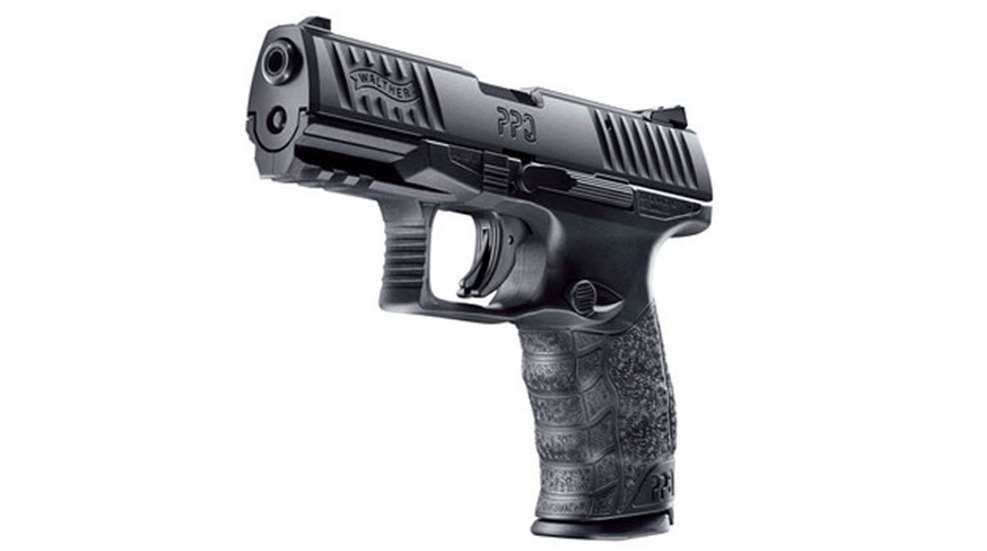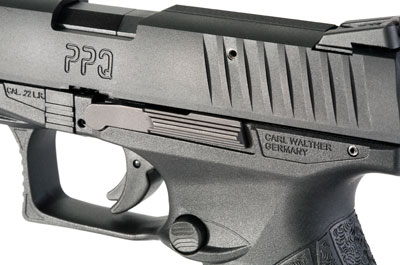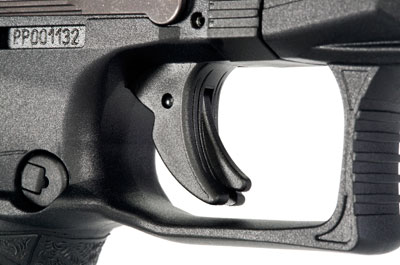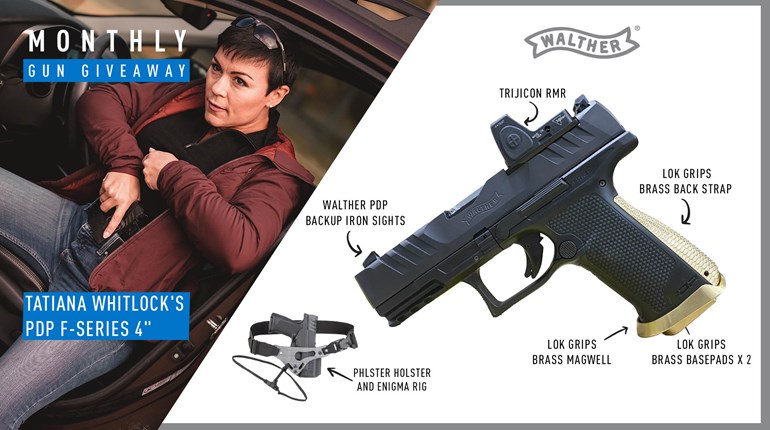
A long time ago, a friend of mine told me about his latest acquisition, a Smith & Wesson Model 34, which is a .22 LR revolver the same size as a standard Chiefs Special .38 Spl. At the time, I thought a short-barreled .22 LR pistol was an odd choice, until I shot it. What I noticed about the rimfire version of my centerfire carry revolver was I could practice with the small sight radius and long trigger pull—without the recoil of .38 Spl. +P—which helped me to fine-tune how I handled my short-barreled-revolver shooting.
I've been a fan of a rimfire stand-in for centerfire handguns ever since, and I've acquired several "trainers" for some of my centerfire handguns. A common lament is trainers are not precise replicas of their larger-bore siblings. They're either smaller in size (like the SIG Sauer Mosquito or Colt New Frontier), or have different controls (like the Ruger SR22). Enter the Walther PPQ M2 .22. It is not only sized identically to the 9 mm and .40 S&W variants, but even features the same controls.
There are some minor differences in the rimfire version, however. It does not come with the ability to change backstraps like the full-size version, so if you prefer either the large grips or the small, it's not going to fit the same. Sights are different as well: the rear sights on the PPQ M2 .22 are flat black, as opposed to the white dots found on the centerfire. The rimfire variant with the longer slide and barrel comes with a fiber-optic front sight, an option not available on the centerfire models.
In practice, the PPQ M2 in .22 LR functioned as well as the 9 mm and .40 S&W versions profiled in our February, 2014 issue. Several hundred rounds were run through the pistol, with exactly one failure to fire. Given the vagaries of bulk .22 LR ammunition, this is high praise for the Walther. Accuracy for the rimfire PPQ M2 was equal to (and in some cases superior to) that of the larger calibers, with all groups less than 3 inches at 25 yards.
Rapid-fire testing at 10 yards gave fist-size groups slightly high and left, indicating the sights could have used some adjustment. Since the rear sight is adjustable, this could have been remedied quickly had I felt the need. Even under rapid-fire conditions, the pistol did not experience any hiccups or failures of any type after the initial single failure, which was not repeated. The PPQ M2 .22's performance would have been exemplary for a centerfire handgun; for a rimfire it was superlative.
Much like its centerfire siblings, the PPQ M2 .22 features ambidextrous controls. The slide stop and take-down levers are mirrored on both sides of the pistol, and the magazine release can be configured for either hand. As these are the only controls on this handgun, it truly can fit either hand. The trigger-mounted safety, becoming more and more prevalent in modern semi-automatic pistols, is simple to actuate and posed no hindrance to rapid fire or accuracy.
Other features the PPQ M2 .22 shares with the centerfire pistols are the forward and aft serrations for chamber checks and recharging ease. An accessory rail for mounting lights, lasers or any other such accessory has three slots for secure attachment. The grips, while not set up for changing the backstraps, are of the same aggressive texture that helps center the pistol in the hand while firing. The magazine dropped cleanly and needed no assistance to clear the magazine well.
For training purposes, it's certainly in my top three for closely matching its full-size counterpart. Dimensionally identical and a functional twin to the centerfire offerings, it would be a valuable addition to the armory of anyone who chooses the PPQ M2 in 9 mm or .40 S&W as a regular defensive sidearm. This does, of course, assume we ever see .22 LR on shelves again at prices somewhat similar to pre-shortage rates.
As a stand-alone rimfire semi-automatic pistol, the PPQ M2 .22 performs quite well. It is simple to operate, works reliably with a wide variety of ammunition and offers exceptional accuracy. Whether you're bringing a new shooter to the range and want a rimfire pistol you know will work, or simply want to spend an afternoon plinking, you'll find this handgun up to the task. When discussing certain items, like automobiles or movies, the word "boring" is a negative. When used in the context of a rimfire handgun, it's high praise indeed—it means that everything went right rather than wrong.
Specifications
Manufacturer: Walther Arms; (479) 242-8500
Action Type: Blowback-operated, semi-automatic
Caliber: .22 LR
Capacity: 12+1 rounds
Frame Material: Polymer
Slide Length: 7.1 inches
Barrel Length: 4 inches
Sights: White-dot front; adjustable rear
Trigger Pull Weight: 5 pounds, 10.5 ounces
Length: 7.1 inches
Width: 1.3 inches
Height: 5.3 inches
Weight: 20.8 ounces
Accessories: Box, lock, manual
MSRP: $429
Shooting Results
| Load | Velocity | Group size | ||
| Smallest | Largest | Average | ||
| CCI Mini-Mag 36-grain CPHP | 869 | 1.52 | 3.73 | 2.40 |
| Remington 36-grain Golden Bullet | 840 | 2.14 | 3.29 | 2.77 |
| Winchester Super X 40-grain CPRN | 947 | 1.97 | 4.37 | 2.97 |
Velocity measured in fps at the muzzle for 10 consecutive shots with an Oehler Model 36 chronograph. Temperature: 68 degrees Fahrenheit. Accuracy measured in inches for five consecutive, five-shot groups at 25 yards from a benchrest.





































